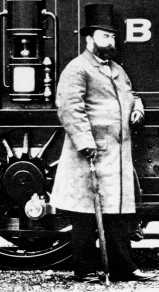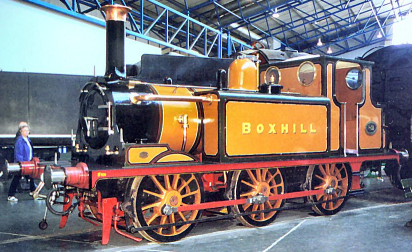 |
 |
 |
 |
 |
 |
 |
|
William Stroudley (1833-1889)
Stroudley took the locomotive superintendent reigns from Craven in 1870, at a difficult time for the LBSCR. Nevertheless, Stroudley must have been well prepared for the financial difficulties he would face because he had come from the Higland Railway. This railway was facing similar economic and practical difficluties as the LBSCR. Although the underlying reasons for the difficulties were the same, the Highland Railway had far lower levels of traffic, and the scope of their operation was much smaller. Whilst at the Highland Railway Stroudley had only managed to design and manufacture a single locomotive. What Stroudley did manage to do for the Higland Railway was to reduce operating costs, and this must have made him a very attractive proposition for the LBSCR. (picture reproduced from Lens of Sutton) Stroudley had some very definite views about the way the railway should be run. In particular, it seems that Stroudley thought the operating staff should feel proud of the work that they did. This could only be done if the staff and the railway were well presented. Stroudly brought about his very attractive golden ochre livery when he joined the LBSCR, with fine lining and a white cab roof. Certainly the cab roof must have been difficult to keep clean, but it is said that Stroudley mandated such cleanliness, and the staff took pride to follow. Many of the early locomotive types developed and procured by Craven, didn't even have shelter for the crew. All that was provided was a simple spectacle plate, behind which the crew might be able to shelter from the worst of the elements. This would have been less of an issue for the LBSCR in the warm southerly climes of Sussex, but I would imagine it was almost life and death in cold winter Scotland. Irrespective, none of the new Stroudley locomotives would go without his very distinctive cab. It seems reasonable to assume that the enginemen welcomed this approach warmly. It would certainly seem that Stroudley was the sort of person one would be keen to have as a boss. It is suggested that he showed concern for his employees, and was keen to hear what they had to say. Perhaps, in part, this was key to his success in his new role. He must have had a clear idea of what the day to day problems were, and was able to do something about them. Among the problems that Stroudley inherited when he joined the railway, was the constraint on the physical size of the locomotives he could specify. In particular the constraint was brought about by the size of the turntables on the line. All were built to fit constrained physical space, and certainly in London land costs in prime locations could easily have been prohibitive. Irrespective, the Brighton locomotive works it's self was not blessed with much space, and keeping the engines small, if possible, must have been a good idea. A reoccuring theme among the design of his locomotives was the lack of a front bogie. None of the Stroudley designs had a leading bogie of any kind. Although some of his locomotives had a leading axle, when demand for larger locomotives came Stroudley's response tended to have no leading axle, and instead have a trailing axle. This was a fairly unconventional approach. On occasion Stroudley stated that this approach was because of the locomotive size constraints, and that the driving wheels should naturally be at the heavier end of the locomotive, by the cylinder block casting. Whilst this seems logical, it is probably also to do with the idea that a leading axle and large driving wheels leads to the top of the driving wheels taking up space in the cab of the locomotive. Once more, from the perspective of the engine crew, this is likely to be a popular approach. Being able to stand close to the cab side means it is easier to look out of the side window, something that all crews must do. 
It is not clear if Stroudley imposed the limitation of not modifying the infrastructure, like turntables, on himself or if it was imposed upon him. Powerful though Stroudley was, it seems that the latter was more likely. Irrespective, it saved money, fitted his policy of standardisation, and meant that there was more money available to configure the locomotive stock suitably for it's task. Not until after Stroudley left office did the passenger demand become such, that large locomotives were required. Unfortunately it is not possbile to predict how his designs would have responded. Probably the most notable Stroudley design was his 0-6-0T the "Terrier" tank (picture kindly reproduced from wikipedia). These engines were designed for light duties, but with lots of small wheels they were very good for the suburban stop-start traffic they were designed to haul. In particular their axle loading was very low, and ideal for lightly laid track. Fifty of the Terriers were built, and they were very popular, performing well. In the end, as passenger demand increased they became unable to deal with the heavy loads. The LBSCR decided to downsize their fleet of Terriers, but were suprised when people wanted to actually buy the locomotives from them. In simple terms they were and still are high quality locomotives ideally suited to light general purpose duties. As a result of these sales, many of the locomotives are still working trains today, and earning money, all over the UK. All over the world the basic outline of the Terrier was broadly duplicated, and most had the characteristic Stroudley touches too. |
Copyright © Solid Fluid 2007-2025 |
Last modified: SolFlu Fri, 24 Jul 2009 15:41:53 GMT |